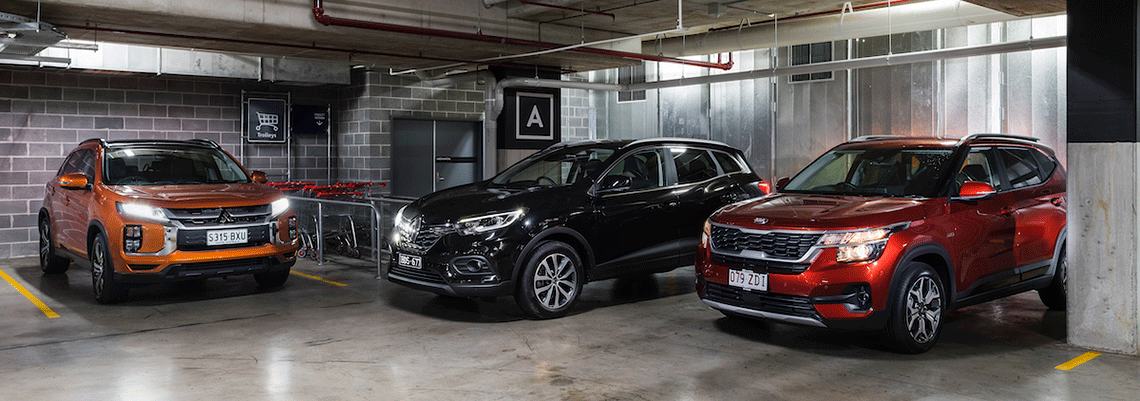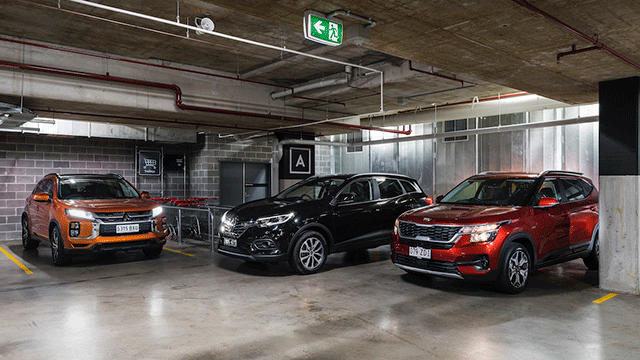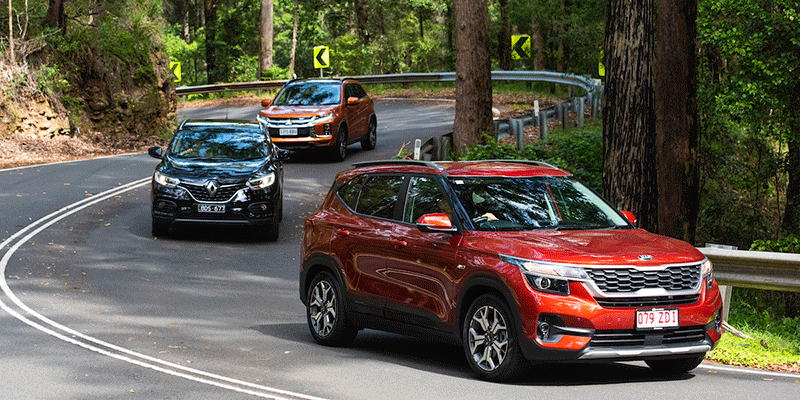Small SUV Shoot-out


It’s the old hand versus two newcomers as we pit the Mitsubishi ASX against the Renault Kadjar and Kia Seltos.
Renault Kadjar Zen
What is it?
The newest addition to Renault’s SUV line-up, the Kadjar sits between the compact Captur and mid-size Koleos, providing the French carmaker with a much stronger portfolio. The segment is rapidly closing in and overtaking small cars, where sales of Renault’s Megane remain static, so the Kadjar’s arrival to market couldn’t have been better timed.
How much is it?
The small SUV is another product of the Renault/Nissan alliance and it shares some of its mechanical architecture with the Nissan Qashqai. Model prices start at $29,990 for the Life, $32,990 for the Zen, and the Intens tops the range at $37,990. Metallic paint is an extra $750 and options are limited to a fixed panoramic roof and auto dimming rear-view mirror on the Zen for $1000. Renault offers a five-year, unlimited kilometre warranty as well as five-year capped priced servicing that amounts to $2385 over the period.
What do you get?
Standard features for the Zen include a seven-inch touchscreen with Apple CarPlay and Android Auto, an electronic instrument cluster, electric handbrake, front and rear parking sensors and a rear parking camera. Safety features include emergency braking assistance, side parking sensors, lane departure warning, blind spot warning, distance warning and inter-urban emergency braking. The range currently has no ANCAP safety rating.
European markets favour smaller capacity turbocharged engines like that under the Kadjar’s bonnet. The 1.3-litre four-cylinder turbo engine, designed in collaboration with Daimler, produces 117kW and 260Nm at 1750rpm. It’s matched to a seven-speed dual clutch transmission (DCT) driving through the front wheels, and the package has a claimed fuel figure of 6.3L/100km.
What's it like inside?
The interior isn’t going to win any design awards. The colour scheme is monotone and the materials aren’t all that tactile on the various touchpoints. The fake cross-stitch treatment on the seat trim is a poor substitute for the real thing, too, and the infotainment touchscreen looks lost sitting low in the dash.
Ergonomically the Kadjar is an acquired taste and, instead of a key fob or remote, Renault is persisting with its a credit card sized keypad. It’s only useful if you keep in it your wallet, otherwise it slides around in the centre console. Renault has also kept audio adjustment on a paddle-shaped stalk mounted on the steering column behind the wheel, and the collection of switches on the steering wheel (where you’d normally expect the audio controls) aren’t clearly marked either. The same goes for the touch symbols around the infotainment screen, which are hard to read.
The Kadjar lifts its game in seating comfort where it outshines the ASX and Seltos. Tacky trim notwithstanding, the seats are enveloping and supportive, with the second-row offering not far behind in comfort. Boot space is similar in all three models tested but the Kadjar’s has a sort of ‘false floor’ divided into two sections. When removed they create a recess and each section can be put into a vertical slot, in effect creating shallow compartments within the boot.
What's it like to drive?
On-road the 1.3-litre turbo’s willing performance makes the Kadjar a delight to drive. It accelerates away smartly with minimal transmission shuffle or wheelspin and is quiet once up to speed. The transmission is quick to respond and the package feels lively on winding sections of road.
Ride comfort is excellent. The Zen is fitted with 215/60X 17-inch tyres and the extra sidewall cushioning soaks up the worst of road surface irregularities adeptly. They don’t hinder handling greatly, either, with lightly-weighted, communicative steering and minimal body roll in bends.

Kia Seltos Sport +
What is it?
Launched last year, the Seltos was a late entrant for the Australia’s Best Cars awards where it claimed top position against some stiff competition. Its line-up is more expansive than the Kadjar’s, offering two engines (a 2.0-litre and 1.6-litre turbo) and 2WD or AWD.
How much is it?
Drive away pricing starts at $25,990 for the S and $36,490 for the Sport + AWD (as tested). The Seltos has seven-year capped price servicing and a class leading seven-year unlimited warranty. Kia’s proven turbocharged 1.6-litre petrol engine (130kW/265Nm) powers the Sport + AWD and is matched to a seven-speed DCT. At 7.6L/100km, its claimed fuel consumption is slightly less than the ASX but somewhat higher than the Kadjar.
What do you get?
The Seltos Sport + wants for little at this price point and standard features include a 10.25-inch touchscreen, satellite navigation with 10 years of map updates, cloth/leather trim, button start, smart remote start, front parking sensors and climate control. The extensive Seltos safety package features full autonomous emergency braking, driver attention alert, smart cruise control, blind spot detection, and rear cross traffic alert. All models achieve a five-star ANCAP safety rating.
What's it like inside?
The interior offers a window to the latest in Kia design, where the infotainment screen floats high and centrally in the dash. Beneath the touchscreen are switches for major controls and a rotary volume dial for audio. Instruments ahead of the driver are large, easy to read and, while they lack the digital clarity and wow factor of the Kadjar’s, are more user-friendly.
The interior colour palette is subdued, like the Kadjar’s, but Kia’s switchgear is better presented and the seat material provides a more premium look. The seats themselves are supportive, albeit a touch firmer than the Kadjar’s plush pews, and little separates them in the second row where there’s adequate leg room and foot space for adults. Luggage space is close, too, although a full-sized spare resides underneath the Seltos’ cargo floor.
What's it like to drive?
Kia’s commitment to ride and handling dynamics that suit Australian conditions has been well documented and the Seltos has been subjected to the same rigour. The ride is firmer and sportier than the Kadjar’s; it does transmit road surface irregularities but it’s in a connected way rather than being too firm or jiggly. The taut chassis is reassuring through the curves, with little body roll or pitching, and the Seltos remains composed when pushed along.
Compared to the Kadjar, the lower profile tyres fitted provide more solid traction and appear to help the steering feel, too, which is more direct and has more weight off centre than the Kadjar’s lighter settings.
Kia’s 1.6-litre turbo engine and seven-speed DCT – the same package used in the Cerato GT sedan – has found a good home under the bonnet of the Seltos Sport +. Like the Kadjar, the Seltos is sharp off the mark with minimal hesitation or delay, and the DCT is quick to respond under acceleration. The package feels stronger in the upper rev range than the smaller turbo unit in the Kadjar, and as far as small sporty SUVs go the Kia Sport + is one of the top contenders.
Mitsubishi ASX Exceed
What is it?
Due to its apparently inexhaustible popularity, we chose the ASX over Mitsubishi’s newer Eclipse Cross SUV for this comparison. When the Eclipse Cross was launched in late 2017, the plan was to offer it alongside the ASX, with a view to ultimately replacing the aging model. But the ASX continues to outsell the Eclipse Cross by a factor of about three to one and the recent upgrade has stretched its shelf life even further.
How much is it?
The broad ASX line-up starts with the 2.0-litre 110kW ES manual priced at $24,990, with the fully loaded Exceed priced at $35,790. Mitsubishi offers three enhancement packs to customise the interior and exterior. Recent upgrades included the grafting of Mitsubishi’s new corporate ‘dynamic shield’ design to the front, which freshens up its appearance without upsetting the original styling. Under the Exceed’s new nose is Mitsubishi’s tried and tested 2.4-litre naturally aspirated four-cylinder engine pumping out 123kW and 222Nm, matched to a continuously variable transmission (CVT).
What do you get?
Standard features include electrically adjustable front seats, leather trim, an eight-inch touchscreen with Apple CarPlay and Android Auto, TomTom navigation and a Rockford premium audio system complete with a large subwoofer mounted in the cargo area. The redesigned front structure enabled Mitsubishi engineers to upgrade the safety package, which now includes forward mitigation warning, lane departure warning, rear cross traffic alert and lane change assistance, giving the ASX a five-star ANCAP safety rating.
What's it like inside?
Inside the cabin the new infotainment screen stands out, literally – it’s not as integrated as those in its newer rivals. The analogue speedometer in the instrument cluster is small and there’s no digital speedo option. The centre console is low to the floor and the traditional handbrake lever, once a common sight, looks strangely out of place in a world gone electric.
The front seats are firm, while those in the rear offer little bolstering to stop passengers sliding around. Rear occupant space is on par with the Seltos and Kadjar, as is the luggage space, which is practical in spite of the large subwoofer mounted on one side. Ergonomically there’s nothing much wrong with the design and, in the words of one Open Road team member, “the ASX just feels right for me”.
What's it like to drive?
The naturally aspirated 2.4-litre engine’s power delivery has a different character, and where those in the Seltos and Kadjar have maximum torque from a low rpm, the Mitsubishi’s maximum torque is higher in the rev range. As a result, it doesn’t feel as smart off the line or during sudden acceleration. Smoothness and quietness levels remain acceptable until you really push the ASX, where its CVT pegs engine rpm and mechanical noise becomes more apparent.
The ASX’s ride and handling package has held up surprisingly well. Its low-profile 18-inch tyres, while delivering good grip levels, mean it lacks the Kadjar’s suppleness. Over our test loop the ASX behaved perfectly, the steering was reasonably sharp and well weighted, and only when pushed hard did some understeer become evident.
Final thoughts
Mitsubishi continues to inject life into the ASX’s veins and the latest Exceed is well kitted out, has more punch than its predecessor and is a time-tested product. Mitsubishi also has capped servicing for 2020 models at $199 for three years, and running and repair costs don’t come much cheaper than that.
The Kadjar takes the fight close to the top and Renault has gone a long way towards erasing higher ownership costs, offering a competitive warranty and capped-price servicing for five years that’s only $360 more than the Seltos over the same timeframe.
But the Kia Seltos’ interior is better finished and more contemporary than the Kadjar’s and its ergonomics are superior. On-road the Seltos shades the ASX by a fair margin, while against the supple-riding Kadjar it’s a closer affair in which the Seltos’ sportier feel gives it the edge. Kia’s drive away pricing, seven-year warranty and seven-year capped price servicing further cement its position as the premier choice in this clash.






